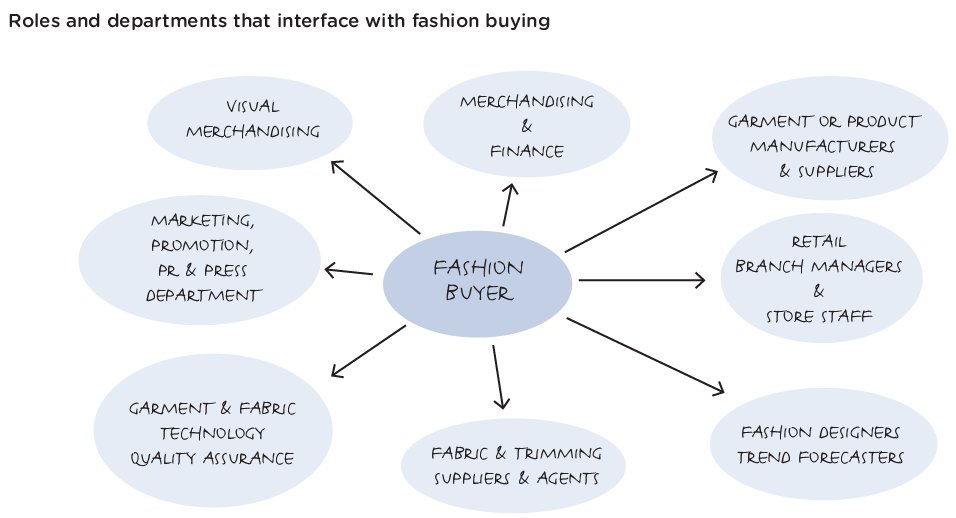7•
Careers in Fashion Marketing
Fashion is an international industry with potential for employment across a wide range of disciplines. This final chapter outlines the key skills required to work as a professional within fashion design, fashion retail management and fashion marketing and promotion. It provides information on some of the day-to-day tasks and responsibilities involved to help you determine which options to explore further so you can decide upon a potential career direction.
Marketing is an essential function of the industry, and affects the entire supply chain, from production and wholesale of raw materials to the design, development, manufacture and promotion of fabrics, garments and accessories, right through to fashion retail and the sale of products to the end-consumer. Marketing is the common denominator linking all the processes together, so whatever role you intend to pursue within the industry, an understanding and appreciation of marketing is becoming an ever more essential skill.

Marketing operates along the entire fashion supply chain. At every stage, businesses need to develop, sell and market products and services that satisfy their business customers’ requirements and meet the demands of the end-consumer.
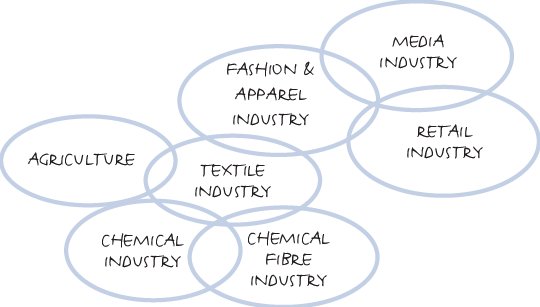
This diagram shows how the fashion industry interfaces with other industries such as media, retail and the textile industry, which has links with both the chemical and agricultural industries.
Fashion can be glamorous and exciting, but it is important to remember that fundamentally it is a commercial business producing and selling fashion and textile products. These must satisfy customer demand and produce profit for the business concerned. To work in the industry you need to be ambitious, self-motivated, creative, energetic and passionate about fashion and have a working knowledge of marketing and business. Employment within fashion is very competitive and you will find that you are required to work at a much faster pace than you did as a student. If you are lucky enough to land a job you should be prepared to put in long hours and be willing to deal with the constant barrage of tight deadlines that most fashion professionals accept as the norm. It is also likely that you will work on more than one project or fashion season at a time, so it is vital that you are organized, accurate and pay attention to detail. Employers will expect you to understand the market, be aware of customer requirements and work within set financial parameters.
An understanding of the target market No matter what role you take on within the industry, you will be expected to understand and grasp the particulars of the specific market targeted by the company for which you are working. Although you might not be required to carry out detailed consumer research yourself, you must make sure that you are informed and aware of relevant consumer and market trends and appreciate the way in which the identity and values of the brand are reflected in the product and services offered to customers.
Commercial awareness If you remember back to the marketing definitions in Chapter 2, you will recall that “marketing is the management process responsible for identifying, anticipating and satisfying customer requirements profitably”. The bottom line is that individual products, collections, marketing schemes and promotional strategies must all be commercially viable and contribute to the profitability of the company. It is important therefore that you grasp the bigger picture and ensure that your creative ideas are also commercial and profitable.
Awareness of corporate business objectives Whether you work for yourself or for a company, you will always have a desired outcome or specific objectives to achieve and there may be key performance indicators set by the company by which you will be judged. It is vital that you always have the business objectives and company strategy in mind when you develop designs or propose schemes for marketing and promotion.
Communication and presentation skills Presentations and meetings are an essential part of professional life so it is important to develop competent skills in this area. The fashion industry operates on long lead-times – product can take anywhere from 1–18 months to be developed. This means that the textiles, garments or accessories under discussion might not actually exist yet, so excellent communication skills, both visual and verbal, will be required in order to explain ideas, discuss concepts and describe products accurately during meetings. Designers, product development teams and buyers developing own-label collections for high-street retailers or purchasing for department stores will be expected to present their product ranges, explain the rationale behind their designs and communicate how the collection and pricing strategy will achieve the company’s overall strategic and financial objectives. It may also be necessary to present to key suppliers and manufacturers so they are aware of the types of styles, detailing and fabrications that they will be required to source, produce or supply.

Confidence with communicating ideas and presenting collections is essential for fashion. Jason Wu presents his collection to Anna Wintour, Editor-in-chief of American Vogue.
Team-work Getting on with and working alongside others is a key professional skill and whatever role you are employed in within the industry, team-work and good communication will be required. Even the most talented designer will not be able to make it totally alone, they are only one facet of the overall picture. Even if it is their name on the label or they are the figurehead behind the brand, they still rely on a team of professionals across a wide selection of disciplines, from pattern cutting, sewing, managing production, sales, promotion, business and marketing.
Skills required to progress within the fashion industry
•Creative flair and commercial awareness
•Evaluating market and business trends
•Strategic thinking and awareness of corporate business objectives
•Ability to research trends and intuit future fashion and market direction
•Team-working skills and ability to work with others
•Ability to negotiate and network
•Strong organizational skills and ability to work to tight deadlines
•Presentation skills and ability to communicate information clearly
•A proactive and flexible approach
•Ability to multitask and work on more than one project or fashion season at a time
•Problem-solving, creative process management and project planning
Career choices
This section shows how an understanding of marketing principles is integral to many key job roles within the fashion industry.
Fashion design
Jobs exist within fashion design at every level of the industry from haute couture, designer ready-to-wear through to high-street fashion or designing for a garment manufacturer. Designers will usually specialize in womenswear, menswear, accessories or childrenswear, although it is possible to work in more than one area. They also tend to stick to a particular market level such as couture, luxury or streetwear. Designers working for a large organization may work for a specific department, such as casual wear, knitwear, outerwear, formal wear or separates. Depending on the type of market and the direction you wish to take you can be employed as a designer or as a fashion and trend forecaster.
Fashion designer
The fashion designer’s role is to design and develop individual fashion products or product ranges appropriate for a specified target market. It is important for designers to have a clear understanding of trends in the overall fashion market as well as solid background knowledge of their particular market and target consumer. This knowledge should assist the designer in determining the correct design concept, product details, fabrications and pricing for their proposed collection or product range.
Typical work activities:
•Reviewing sales results from current and previous season
•Researching trends and undertaking inspirational shopping trips
•Developing and presenting concepts for the new season

The ability to work as a team is another vital skill. Designers rely on a team of skilled technicians to help them realize their creative ideas.
•Sourcing fabrics, materials, components, trims and embellishments
•Designing and developing product ranges
•Overseeing creation of prototypes, producing accurate product specifications for samples and production
•Managing sampling process and fittings
•Liaising with manufacturers and suppliers for sampling and production
•Confirming range selection with management, buyers and other relevant personnel. Presenting final range to internal staff or external buyers.
•Approving final colours, bulk fabric and trimmings
•Presenting ranges to management, sales staff and buyers
Fashion designer: key skills
•Professional knowledge of fabrics and materials
•Ability to illustrate and draw technical details accurately
•Creative flair and commercial awareness
•Good eye for proportion and colour
•Self-motivated
•Ability to research and monitor trends
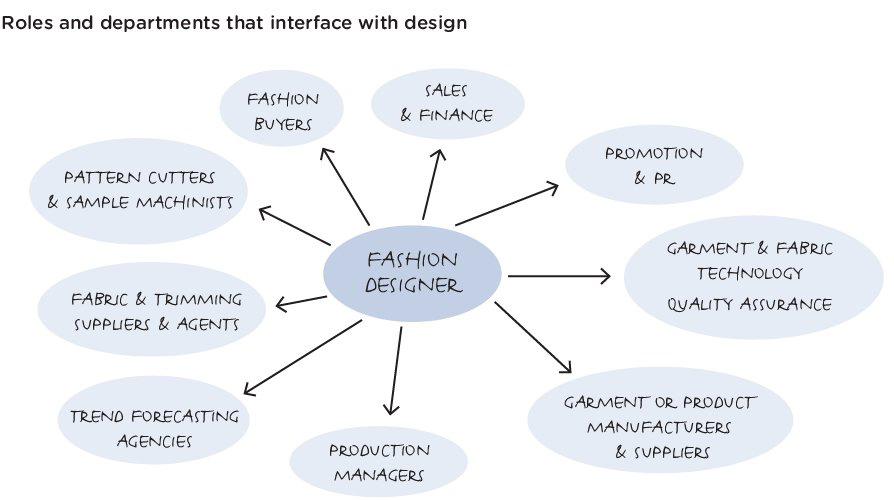
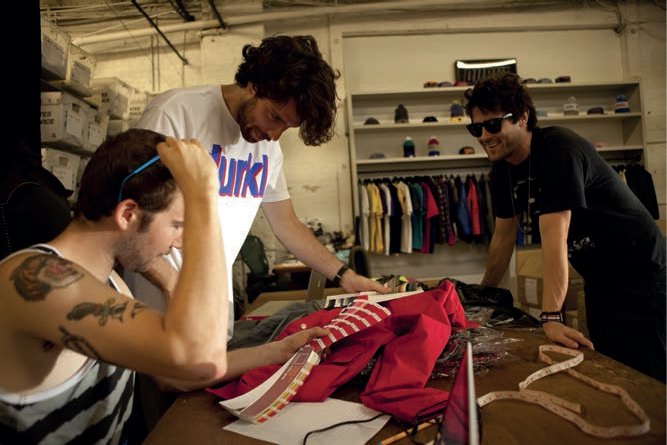
The team behind the streetwear label Durkl Clothing working in their studio in Washington, DC.
Visitors to Première Vision look at fabric samples for Autumn/Winter 2010. Fashion designers, buyers and trend forecasters will all travel to relevant fabric and trade fairs to monitor trends, gather information or place orders.
Fashion and trend forecaster
Fashion and trend forecasters work approximately 18 months to two years ahead of the season in order to develop and compile trend and market reports purchased by the industry. Fashion forecasting and prediction agencies provide information on current and developing consumer trends and emerging fashion and textile trends in womenswear, menswear and childrenswear. They produce presentations and printed and/or online reports that include colour palettes, design illustrations, print and fabric designs and technical flat drawings of product so that companies who purchase their services can see how the predicted trends will translate into product designs.
Trend forecaster: key skills
•Self-motivated and ability to research
•Awareness of what is going on culturally in music, art, street fashion and film
•Creative flair and commercial awareness
•Good eye for colour
•Ability to produce fashion illustration and technical flat drawings to a high standard
•Good networking skills
•Ability to analyse trend data
Typical work activities:
•Visiting trade fairs or working on an agency stand to sell prediction packages at fairs like Première Vision
•Travelling to research trends
•Compiling visuals and colour palettes for key trends and fashion themes
•Researching technical developments in fabrics, materials, components, trims and embellishments
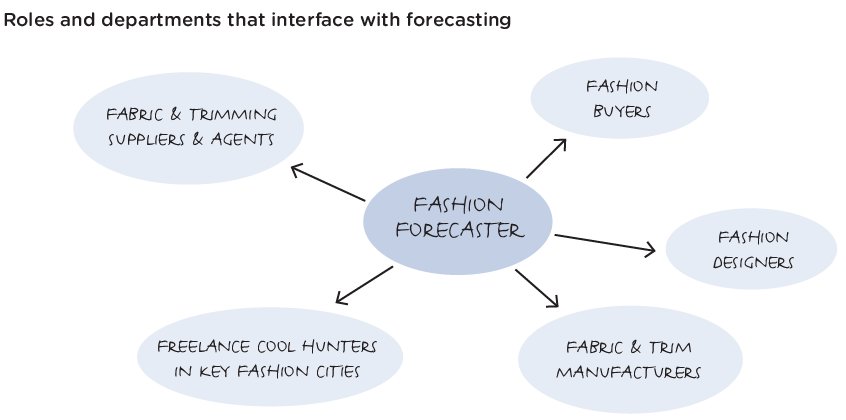
Retail culture is high pressure and demanding. Stores are open six or seven days a week, virtually 365 days a year. If you want to work in this sector you will need to be committed and proactive – retailing is never fully predictable and the situation changes daily so you will need to be able to respond to each challenge that arises. The head-office or behind-the-scenes jobs outlined in this section are retail buyer, merchandiser and visual merchandiser.
Retail buyer
Buyers source, develop and select product ranges. They must understand customer needs and predict consumer demand in order to select commercially viable ranges of merchandise that appeal to the target market. Career opportunities for fashion buyers exist in two main areas, either working for retailers selling their own label ranges or for an individual boutique, small boutique chain or department store selling wholesale and designer fashion labels and brands. Retail buyers have considerable responsibility to achieve a company’s financial targets and create profit, so they must have a good head for business, be aware of current trends and shifts in consumer demand, keep up to date with what competitors are up to and respond effectively to change.
Retail buyer: key skills:
•Keen eye for fashion
•Excellent commercial awareness
•Strong communication and negotiation skills
•Numerate
•Accurate
•Ability to work to tight deadlines
•Ability to monitor fashion trends
•Awareness of competitors within the market
Typical work activities:
•Researching fashion trends and analysing consumer buying patterns
•Attending fabric and trade fairs
•Sourcing, developing and selecting product ranges
•Working with a merchandiser to create range plan
•Negotiating with suppliers and manufacturers
•Reviewing and analysing sales performance
•Managing supplier relationships and sourcing new suppliers
•Travelling to manufacturers both in home market and overseas
•Visiting stores to review performance and meet with store managers
•Writing reports and presenting ranges to management

Buyers placing orders with Danish label nümph on their stand at the Bread & Butter trade fair in Berlin.
Garment fitting and approval
Designers, buyers and product technicians usually work as a team to fit garments and approve product specifications.
At American outdoor brand, Nau, the team pay meticulous attention to key details as well as to the look, fit and feel of a garment. Every aspect of the jacket being fitted, right down to buttons, closures, pockets, zips and stitching, has to be approved and specified accurately. At Nau garments are specifically cut to increase ease of movement. Sleeves are cut longer than average, to ensure wrist coverage when reaching for a hold while climbing or holding bicycle handlebars, and tops are cut lower in the rear to keep wearers warm when bending. The designers also work closely with fabric suppliers to create new, more sustainably produced technical fabrics that deliver on performance, hand-feel and drape.
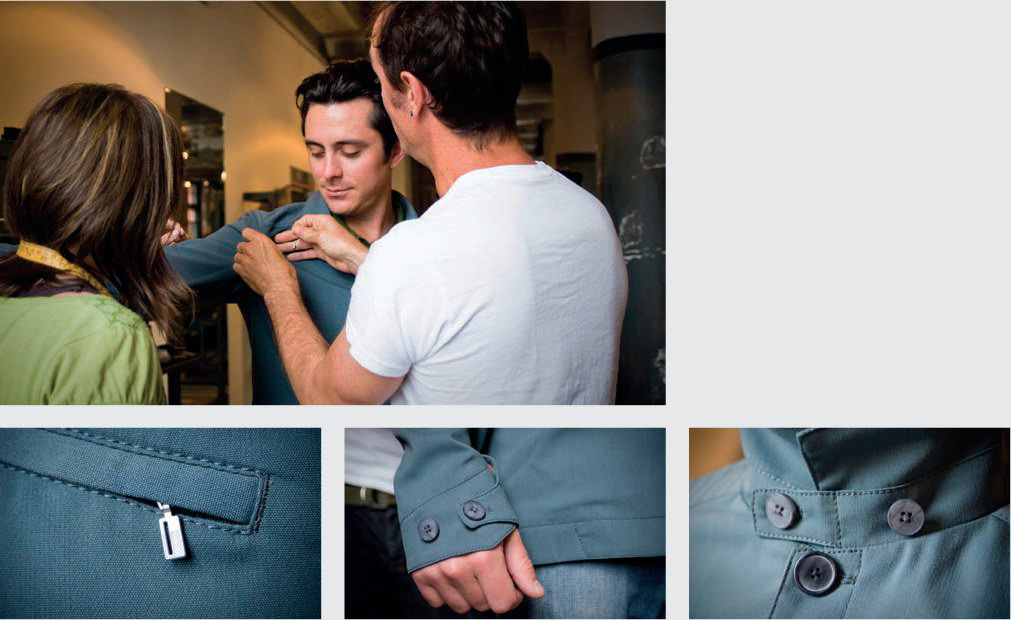
Merchandisers are responsible for the budget and work to maximize a retailer’s profitability by ensuring that products appear in the right store at the appropriate time and in the correct quantities. Merchandisers work very closely with buyers to plan ranges and determine what quantity of each style should be bought. They must make sure the buyer stays within budget and that the range will achieve margin and profit targets. Merchandisers must also co-ordinate and liaise with suppliers to monitor deliveries and work with the distribution and warehouse departments to ensure the right amount of stock is sent to the correct stores. Merchandisers monitor the daily and weekly sales figures and must be proactive in devising markdown or promotion strategies. In a small company, the same person may have to do the buying and handle the merchandising.
Merchandiser: key skills
•Numerate with excellent analytical skills
•Accurate
•Strong computer skills and ability to use IT packages
•Understanding of product manufacture
•Strong negotiation skills
Typical work activities:
•Budget planning
•Working with buyer to plan product ranges
•Liaising with buyers, suppliers, distribution, stores and management
•Analysing financial data
•Forecasting potential sales, profits and stock figures
•Devising markdown and promotional strategies to mitigate losses and maximize sales and profit
•Presenting financial data, sales forecasts and stock information to management
•Negotiating delivery dates and stock quantities with suppliers
•Travelling with buyers to visit manufacturers
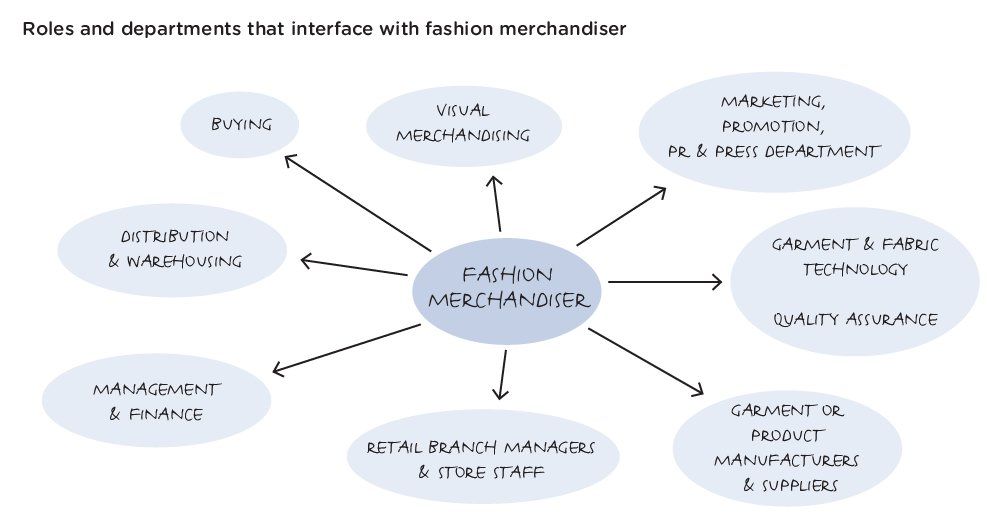

SAKS Christmas windows 2008.
Visual merchandiser
A visual merchandiser is responsible for creating and installing schemes for windows and in-store displays with the aim of drawing customers into the store, promoting merchandise and maximizing potential sales. Displays and promotions will be designed to fit in with important annual events such as the launch of the Spring and Autumn seasons and Christmas, Valentine’s Day or Easter. Large and medium-sized companies may employ their own visual merchandising (VM) team, but they could also use the services of a specialist retail or VM consultancy. Owners of smaller businesses may ‘do it themselves’ or use the skills of a freelancer. If you are interested in working in VM, then be prepared to lift and carry props and mannequins, climb ladders, adjust lighting and paint backdrops. You may also be required to travel, usually from store to store, and work unsociable hours – changes in displays and installations usually take place at night when the store is closed to avoid disruption or loss of sales.
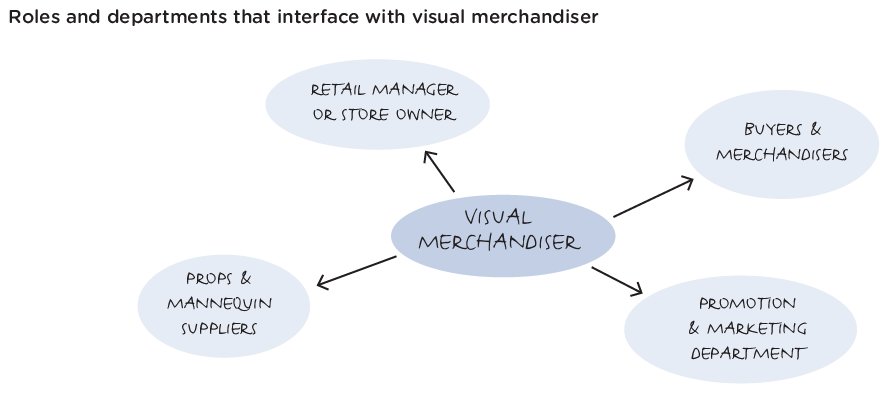
Window displays are an important element of the visual merchandiser’s job. This dramatic scheme for Harvey Nichols in London illustrates how colour can be used to promote summer merchandise.
Typical work activities:
•Researching and devising display concepts and schemes
•Creating concept boards and presenting schemes to colleagues
•Technical drawing by hand or CAD of windows and floor plans
•Sourcing materials and display elements, such as lighting, props and accessories
•Installing and dismantling displays
•Dressing mannequins
•Creating VM informational packs sent out to stores
•Visiting stores and training sales staff
Visual merchandiser: key skills
•Creative flair and good eye for composition, proportion and colour
•Understanding of how to communicate brand identity within visual displays
•Good knowledge of fashion trends
•Strong display techniques
•Ability to work to tight deadlines
Fashion marketing and promotion
Describing the career options within fashion marketing is somewhat complicated by the fact that interpretations of exactly what comes under the banner of marketing vary considerably depending on the requirements and structural set-up of a particular company. This makes it much harder to define individual job roles, as some view marketing as a sales-related role, others regard it as a management function, and there are those that consider it to mean promotion and PR, so job options could be in any of the following:
•Sales and marketing
•Brand management/product management
•Promotion and PR
To work in sales, marketing or promotion you will need to be a people person and a good communicator with strong verbal and written communication skills. You should enjoy networking and be willing to socialize as part of your work. You should also be proactive, organized and flexible.
Behind the scenes the team prepare for London Fashion Week.
Brand management/product management
Brand management focuses on the strategic management of a brand and the development and maintenance of the brand identity. Marketing management encompasses a variety of roles and again these will be dependent on each company’s requirements. If you check recruitment agency websites for fashion marketing jobs you will notice adverts for product management. Product managers are responsible for overseeing the overall process of developing product and bringing it to market. They usually handle a specific product or product category, overseeing the entire process of conceptualization, design, production, selling and distribution of a manufacturer or designer’s products. With so much responsibility it is no surprise that a product manager is a senior level job; you will probably need to start in an assistant position and work up. You will also need a degree in business administration, marketing, or apparel production. As product managers gain extensive experience and knowledge of the manufacturer’s operations, they can be promoted into an executive leadership position.
Brand management: key skills
•Highly analytical
•Numerate with strong skills in maths
•Knowledge of apparel manufacture
•Ability to analyse and utilize data from sales, production and fashion forecasts
•Well-organized
•Attention to detail
•Ability to deal with pressure and tight deadlines
•Ability to present and communicate detailed information to others
•Good negotiation skills
Typical work activities:
•Working with a technical team on product design, construction and manufacture
•Sourcing manufacturers and negotiating production contracts
•Planning production and delivery schedules
•Negotiating distribution rights
•Writing detailed marketing and business reports
•Reviewing sales results and analysing data
•Monitoring fashion and market trends
•Forecasting and preparing monthly and annual sales targets for specific regions
•Researching and developing new product lines
•Travelling to visit overseas manufacturers and distributers
Fashion PR is about promotion and image. The aim of PR is to gain media coverage to promote and generate a favourable image of an organization, brand or fashion label. To work in PR you will need to get on well with a broad spectrum of people, be sociable and a good networker. PR people need to build strong working relationships with their clients and with members of the fashion press.
Typical work activities:
•Writing press releases and handling press enquiries
•Creating press packs and goodie bags for fashion shows and events
•Sending garments out to magazines to be featured in fashion shoots and editorial
•Creating look books and style books to give to press and buyers
•Running press days to view collections
•Developing and managing product launches, special events or parties
•Managing the guest lists for fashion shows, events, store openings, shopping evenings, retail events or product launches
•Managing business communication or news stories concerning announcements on trading figures
•Informing press of newsworthy stories, sponsorship deals, celebrity endorsements or designer collaborations
•Handling negative news stories and limiting any damage that might be caused

PR personnel are responsible for sending sample garments out to the fashion and national press so they can be featured in editorial fashion spreads or in articles on key trends or what’s hot in the shops.
Promotion and PR: key skills
•Strong verbal and written communication skills
•Good networker and confident in social situations
•Proactive, organized and flexible

When applying for a position, you need to consider the type of organization you wish to work for, which level of the market your skills are best suited to, and whether you wish to work in womenswear, menswear, childrenswear, accessories or specific sectors such as sportswear or knitwear. Research the market to determine which companies are doing well; you are most likely to be employed by a company experiencing growth. Read the business sections of newspapers and check out industry websites for information. You can find out about appointments and employment opportunities from:
•Recruitment agencies
•Trade fairs, exhibitions and graduate employment expos
•College and university careers departments
•Appointment sections in industry publications such as Drapers or Retail Week
•Networking and word of mouth
•Contacting companies directly by calling their HR department and sending out your CV and a covering letter
Research into companies you might be interested to work for. Most company websites have a section where you should be able to find annual reports and financial results. Check out the size of an organization, number of employees, sales turnover and profits. Take a look at the company mission statement, brand values and objectives and consider if you might fit in to the organization. Go to the press section of the website and look at the most recent press releases.
If you are happy to work in a corporate environment and want a job in mass market fashion, you could consider retail organizations like Gap, Marks & Spencer, H&M, Zara, Topshop, Mango or Banana Republic. If you are more independently minded then you might prefer to work for a smaller organization. Salaries tend to be lower and there are fewer benefit packages but with fewer employees, you are likely to get exposure to more aspects of the business and gain excellent first-hand knowledge. Another option is to work for a supplier or manufacturer. Designers employed by this sector may meet with buyers from high-street retailers to discuss trends and decide what type of styles they wish you to develop. You might present ideas you have researched on their behalf, show them designs or development samples and hopefully take orders if samples are approved. Working for a supplier can be very hands-on and exciting but it is also pressurized. Clothing and footwear prices fell by 8 per cent in the 12 months to May 2009 in the UK; suppliers are challenged to keep cost prices low and they may be dropped by a retailer if they do not perform, so jobs in this sector are not always secure.
Work experience and internships
Work placements and internships are a good first step for your career. Although you might not be paid, you will benefit from gaining first-hand industry knowledge. If work placements are not offered as part of your course curriculum, then it is advisable for you to seek an internship or paid work during your holidays so that you can practise skills, gain professional knowledge and increase your confidence. The reality of working life can be very different from your college studies. An investigation into Employer Engagement, Work-Related Learning and the Student Experience by Catherine McConnell (Skillfast-UK, 2008) described student experiences of the workplace. One student found it hard to think about structure and design first and not about theme and colour as they had at college. The experience helped them realize how quickly you have to work in the industry and why there isn’t time to get arty and spend weeks on sketchbooks. Some students find the work they undertake as an intern boring or repetitive, but it is worth persevering, as one student discovered when they had to mount a large volume of fabric swatches onto card; the experience helped improve their attention to detail and presentation. Industry experience is extremely valuable and will help you learn how to conduct yourself and carry out work in a professional manner.
Writing a CV and covering letter
A CV (curriculum vitae) or résumé is an important professional tool used to advertise your experience and skills. A CV should summarize your work experience to date, outline your skills and detail your education and academic accomplishments. There are two types of CV you can consider. A chronological CV gives details of your employment history in chronological order; this format should be used if you have industry experience. A functional CV is more suitable for graduates and college leavers; this format focuses on skills and qualifications.
A CV should begin with your name, address, contact details and date of birth. The next section should be the professional profile, a concise statement describing your experience, skills, abilities and personal qualities. On a chronological CV the profile will be followed by your work experience and educational details in reverse chronological order. On a functional CV the profile will be followed by a section listing your skills. Additional information can then be listed, making sure it is relevant to the job. Interests come last. For references, it is best to state, ‘references available on request’. It is courteous to ask someone if they are willing to be your referee and if they agree for you to give out their details.
The CV should be sent out with a covering letter outlining why you want to work for the organization in question. The letter should be brief, no more than one side of A4. It should state which post you are applying for, why you want the job and indicate the experience, skills and personal qualities that you believe meet the requirements of the company and the role they are advertising. Make sure the letter is typed (unless a handwritten letter is specified by the company). Use top-quality white or cream A4 paper, ideally the same as you have used for your CV. If you are writing to a specific person, then the letter should start ‘Dear (insert correct name)’ and end ‘Yours sincerely’. If you do not have a specific name, then begin, ‘Dear Sir/Madam’ and finish ‘Yours faithfully’.
It is possible that a company you wish to work for is not currently advertising for a position. In this instance you can send out a speculative CV and covering letter explaining what type of job you are interested in. Many companies keep CVs on file, and they may contact you if they are interested in you and a suitable position should arise. It is important to address a speculative CV to a specific person, so contact the company by phone and find out who you should send the letter to, making sure you spell their name correctly.
CV tips:
•CV’s should be typed
•First impressions count so print your CV on best quality white or cream paper
•The CV should be on one (maximum two) A4 pages
•Do not print double sided; make sure each page is printed separately
•Do not use coloured paper or coloured ink as CVs are likely to be faxed, scanned or photocopied by potential employers
•The layout should be simple and look professional. Make sure the CV is easy to read; use white space to separate sections and keep to one font throughout. Headings can be in bold or a bigger font size to make them stand out.
•Send your CV out unfolded in an A4 envelope
•Use a spell check and double check your CV for mistakes. A good idea is to ask someone else to proofread it – they will usually spot spelling mistakes and typos that you might have let slip through.
•Avoid using jargon and acronyms
Interviews
Interviews vary enormously depending on the job role, the level of the job and the type of company involved. The interview may be an informal chat or could involve a panel of interviewers, you might be expected to make a presentation, or the recruitment process might be conducted in a group with other candidates.
Informal interview These may be carried out by telephone or in a public place like a hotel lounge or café. They are often used by a company when they wish to meet or talk to someone informally to learn more about them and see if they might fit into their organization.
Pre-screening Companies use a recruitment agency or someone within their own Human Resources department to conduct an interview to pre-screen candidates. This may take place face to face or on the telephone; the purpose is to verify details of your CV and check you have the minimum qualifications required.
Selection interview This is the next step in the process. Interviewers already know that pre-screened candidates have the right skills, so are looking to see who has the right attitude and personality and could fit in with other employees within the organization. Interviews may be carried out by one person, a series of different people who each interview the candidate one by one, or by an interview panel. If successful, you may be offered the job or invited back for a second interview.
Panel interview Panel interviews are conducted by several people at once. The panel is usually made of managers from departments you will work with if you get the job. Members of the interview panel will take it in turn to ask you questions. Keep calm and make eye contact with each panel member when you respond to them.
Group interviews and assessment centres Candidates may be interviewed as a group; this allows an organization to see how candidates interact with each other and assess if they are team players or have leadership potential. Assessment centres are special recruitment days where candidates perform a series of tasks and exercises such as group discussions, presentations and leadership exercises.
You should get an opportunity to ask questions at the end of the interview. Start with questions about training and appraisals. You can ask about career prospects and opportunities for growth and clarify any queries about job specification and responsibilities. Save questions about pay and holidays until last or, even better, double check details with Human Resources before or after the interview. Find out when you can expect to hear if you have been successful, and don’t forget to thank the interviewer for their time before you leave.
Interview tips:
•Prepare thoroughly, research the company and gather background information on the skills required for the job.
•Research latest industry developments and trends so that you are knowledgeable and informed if asked during your interview.
•Confirm beforehand if you are expected to take anything with you such as examples of previous work or a portfolio.
•Make sure you know exactly where to go, how to get there and allow enough time for transport problems or hold-ups. It is better to be early than late. Try to arrive about ten minutes ahead of your interview time so that you can take time to breathe and unwind from the journey.
•Think about a suitable outfit to wear and make sure it is clean, presentable and still fits! It’s a good idea to try your outfit on well before the day of the interview, check for missing buttons, holes or dropped hems.
•Take a copy of the job application and your CV with you. You can read these in preparation while travelling or waiting.
It is worth considering the type of language you use within a professional situation. Below is a list of positive words and action words you might find useful when compiling your CV or attending an interview. Make sure you choose ones that are suitable, relevant and true to you.
POSITIVE WORDS
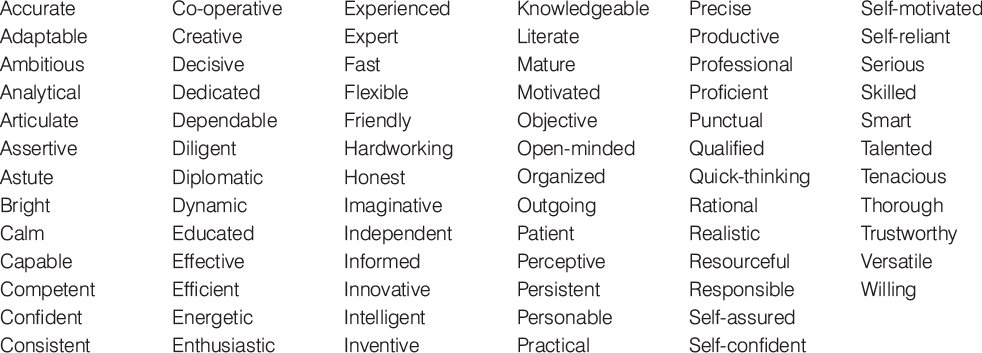
ACTION WORDS
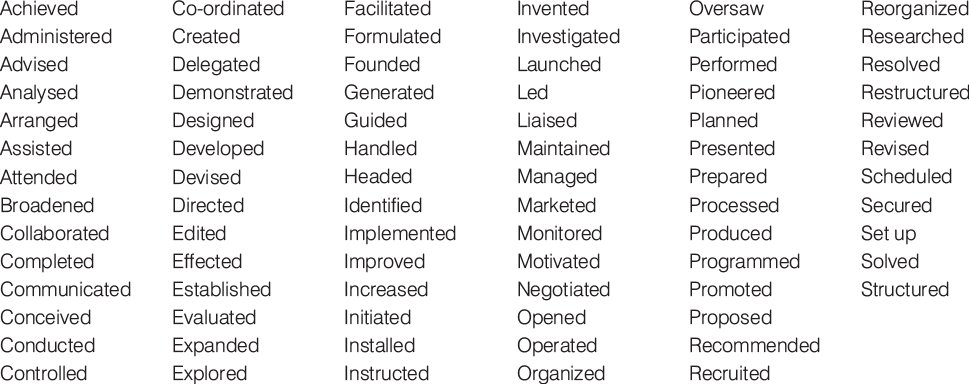
Source: The Careers Department, Plymouth College of Art
A portfolio of work that shows off your abilities and skills is an important marketing tool for those seeking employment as a fashion designer. Make sure your portfolio is organized, neat and professional and that the work displayed plays to your strengths. Select work that showcases your skills in fashion drawing and illustration, technical drawing, fabric selection, range building, print design, use of colour, creating colour palettes, computer-aided design (CAD), Photoshop, photography or fashion styling.
Consider the content and layout; it is advisable to put your best quality work at the front, making sure it is targeted at the company and the job for which you are applying. Each project or section within the portfolio should start with an inspiration or concept page followed by 4–6 pages of design work. These should include illustrations of your proposed collections as well as professional flat technical drawings and fabric swatches. Flat working drawings should be precise and neat so viewers can easily see design details, stitching and closures. Update your portfolio with new work on a regular basis; remove older material – anything over two years old should be taken out or kept to a minimum.
Portfolio tips:
•Choose the best size portfolio to showcase your A3 and A4 work well. You can use A2 but don’t go too big as you will have to carry the portfolio around and potential employers can find it frustrating to handle overly large or unwieldy folios.
•Each project in the portfolio should be presented in a style that is both professional and reflective of the market and consumer for which it is intended. Give each project a title, include a limited amount of explanatory text and annotate designs. A viewer should be able to understand your work without you having to give lengthy verbal explanations.
•Take the time to double check all written content, especially titles, technical terms and designer or brand names to make sure they are spelt correctly.
•Present work either in landscape or portrait format; try not to mix the two as it can be annoying for a viewer to have to keep turning the portfolio to view the work.
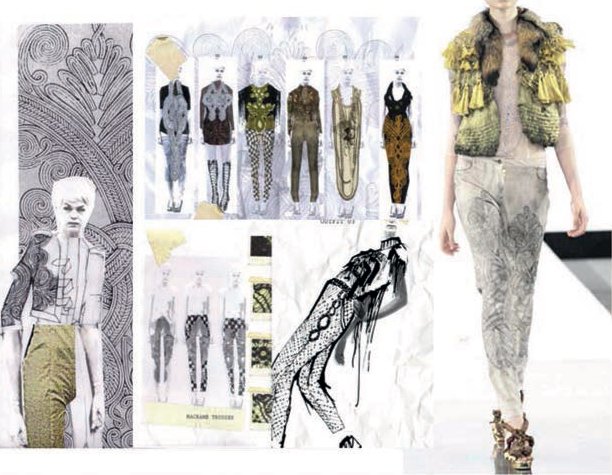
Portfolio design work by fashion graduate Beatrice Newman featured online on the recruitment website, www.artsthread.com. Newman’s collection, entitled ‘Opulence of Empires’, is inspired by the sumptuousness of Russian Tsars and The Arabian Nights. The collection incorporates rich colours such as gold and coppers and uses embellishment, pattern and prints from palace interiors and Russian carpets.


